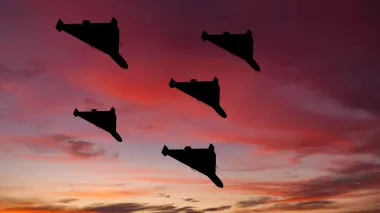Estonian Intelligence predicts drop in Russian drone attacks on Ukraine

Estonian intelligence has suggested that Russian drone attacks on Ukraine may decrease due to the escalating situation in the Middle East.
Source:Colonel Ants Kiviselg, Head of the Intelligence Centre of the Estonian Defence Forces, writes Estonian public broadcaster ERR, as reported by European Pravda
Details:Commenting on attacks using cruise and ballistic missiles, as well as drones, Kiviselg noted that a certain pattern is visible from the Russian side.
Quote:"Usually Russia uses an average of 150 attack drones per day, but the attacks are carried out in series: within four to five days, 60 to 70 drones are launched, after which the accumulated forces are used for a large-scale strike – the simultaneous launch of 350 to 450 drones."
He drew attention to the fact that such tactics are used to fire missiles – both cruise and ballistic.
Kiviselg noted that Russia is increasingly resorting not to targeted attacks on one target but to scattered attacks on various targets – in particular civilian targets and residential areas.
"The new reality is that if earlier attacks on civilian infrastructure were isolated, now they have become systemic. Vivid examples are the attack on Kyiv on the night of 16-17 June and the attack on Odesa on Thursday night," he said.
At the same time, he also said that reducing the intensity of drone attacks by the Russian Federation is theoretically quite possible and may be associated with an aggravation of the situation in the Middle East.
"We know that Israel had the opportunity to strike at the drone plant in Iranian Isfahan, and the Ukrainians repeatedly attacked the plant in Yelabuga (Tatarstan), where drones are also made for the Russian army," he said.
Therefore, according to Kiviselg, it is possible that in the near future "we will see a certain decrease in the intensity of drone use".
"At the same time, we are confident that the Russian Federation is already planning further steps to not only support but also increase the production of drones," he concluded.
In addition, Kiviselg said that Russia’s summer offensive, which has been ongoing for the second month, "has actually stalled in eastern Ukraine because of the stubborn defence of Ukrainians and has turned into tactical hostilities in which Russians are trying to advance despite heavy losses."
According to Kiviselg, the intensity of Russian attacks remains at the same level as in previous weeks – about 150 to 160 attacks daily.
"Based on the nature of the attacks, we can say that the main efforts of the Russian Federation are concentrated on the Pokrovsk front in Donetsk Oblast, where half of the clashes take place," he said.
Commenting on the situation in Sumy Oblast, Colonel Kiviselg noted that, despite initial successes and constant attempts, the offensive there has generally been halted.
"The Ukrainians themselves commented on the initial successes of the Russians by the fact that they were not sufficiently prepared and did not have defensive fortifications in this zone – a mistake that has already been corrected," the Estonian intelligence officer added.
He also commented on potential further actions of Russia. According to Kiviselg, despite the fact that the strategic goals of the Russian Federation have not changed, it is not able to achieve a breakthrough in any sector of the front and the Armed Forces of Ukraine can control the pressure.
Background:
- On the night of 16-17 June 2025, Russia launched a large-scale attack on Kyiv, striking a residential high-rise building with a ballistic missile. As of noon on 18 June, the death toll had risen to 28.
- Lithuania summoned the Russian Federation’s chargé d’affaires to its Ministry of Foreign Affairs in response to the attack.
- On 18 June, several embassies joined a day of mourning in memory of the victims, lowering their flags.
Support Ukrainska Pravda on Patreon !










